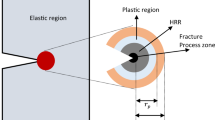Abstract
With introducing the strain gradient into plasticity theory, the crack field singularity at the crack tip changes. Characterization of the crack in strain-gradient dependent materials has not found a common consensus. In the present work the crack tip field is systematically investigated within the frame of the strain-gradient plasticity using the element-free Galerkin method. Under both small scale yielding and finite yielding conditions the crack field in strain-gradient plasticity consists of three zones: The elastic K-field, the known plastic HRR-field dominated by the known energy release rate, \({\mathcal G}\), and the hyper-singular stress field which cannot be characterized by the known fracture mechanics parameters. Effects of the finite strains have been considered for both small scale yielding and finite cracked specimens. The computational results show that the finite strains do not change the characterization of the crack tip fields under the strain-gradient plasticity. In all investigated cases the hyper-singular zone is small (\({r < \mathcal G/\sigma_0}\)) and well contained by the HRR zone under the \({\mathcal G}\) dominance condition. The hyper-singular zone is in the size of \({r/(\mathcal G/\sigma_0)}\) and may grow with the material length, but decrease with applied load. The known elastic-plastic fracture mechanics parameter, \({\mathcal G}\), can be directly applied to characterize the crack under strain-gradient plasticity, within the intrinsic material length much smaller than the overall component size, l < 0.1%L 0. In this case the strain-gradient term in the gradient plasticity will not affect description of cracks.
Similar content being viewed by others
References
ABAQUS (2008) Analysis user’s manual. version 6.8. simula, providence
Aifantis EC (1987) The physics of plastic deformation. Int J Plast 3: 211–247
Anderson TL (2003) Fracture mechanics—fundamentals and applications. 3. CRC Press, Boca Raton
Belytschko T, Liu YY, Gu L (1994) Element-free Galerkin methods. Int J Numer Methods Eng 37: 229–256
Chen J, Yuan H (2002) A micromechanical damage model based on gradient plasticity: algorithms and applications. Int J Numer Methods Eng 18: 399–420
Fleck NA, Hutchinson JW (1993) A phenomenological theory for strain gradient effects in plasticity. J Mech Phy Solids 41: 1825–1857
Fleck NA, Hutchinson JW (1997) Strain gradient plasticity. In: Hutchinson JW, Wu TY (eds) Advances in applied mechanics, 33. Academic Press, New York, pp 295–361
Gao H, Huang Y, Nix WD, Hutchinson JW (1999) Mechanims-based strain gradient plasticity—Theory and experiment. J Mech Phy Solids 47: 1239–1263
Huang Y, Chen JY, Guo TF, Zhang L, Huang KC (1999) Analytic and numerical studies on mode I and mode II fracture in elastic-plastic materials with strain gradient effects. Int J Fract 100: 1–27
Huang Y, Gao H, Nix WD, Hutchinson JW (2000) Mechanism-based strain gradient plasticity - II. Analysis. J Mech Phy Solids 48: 99–128
Huang Y, Qu S, Hwang KC, Li M, Gao H (2004) A conventional theory of mechanism-based strain gradient plasticity. Int J Plast 20: 753–782
Huang Y, Zhang L, Guo TF, Hwang KC (1997) Mixed mode near-tip fields for cracks in materials with strain-gradient effects. J Mech Phy Solids 45: 439–465
Jiang H, Huang Y, Zhuang Z, Hwang KC (2001) Fracture in mechanism-based strain gradient plasticity. J Mech Phy Solids 49: 979–993
McMeeking RM (1977) Finite deformation analysis of crack tip opening in elastic-plastic materials and implications for fracture initiation. J Mech Phy Solids 25: 357–381
Nix WD, Gao H (1998) Indentation size effects in crystallie materials, A law for strain gradient plasticity. J Mech Phy Solids 46: 411–425
Pan X, Yuan H (2009) Applications of meshless methods for damage computations with finite strains. Model Simul Mater Sci Eng 17: 045005
Pan X, Yuan H (2009) Computational algorithms and implementation of element-free Galerkin methods for nonlocal damage models. Comput Mater Sci 46: 660–666
Pan X, Yuan H (2009) Applications of the element-free Galerkin method for singular stress analysis under strain gradient plasticity theories. Eng Fract Mech. In print
Qiu X, Huang Y, Wei Y, Gao H, Hwang KC (2003) The flow theory of mechanism-based strain gradient plasticity. Mech Mater 35: 245–258
Qu S, Huang Y, Jiang H, Liu C, Wu PD, Hwang KC (2004) Fracture analysis in the conventional theory of mechanism-based strain gradient plasticity. Int J Fract 129: 199–220
Shi MX, Huang Y, Gao H, Hwang KC (2000) Non-existence of separable crack tip field in mechanism-based strain gradient plasticity. Int J Solids Struct 37: 5995–6010
Swaddiwudhipong S, Hua J, Tho KK, Liu ZS (2006) Finite element modelling for materials with size effect. Model Simul Mater Sci Eng 14: 1127–1137
Wei Y, Qiu X, Hwang KC (2004) Steady-state crack growth and fracture work based on the theory of mechanism-based strain gradient plasticity. Eng Fract Mech 71: 107–125
Yuan H (2002) Numerical assessment of cracks in elastic-plastic materials. Springer Verlag, Berlin
Yuan H, Brocks W (1998) Quantification of constraint effects in elastic-plastic crack front fields. J Mech Phys Solids 46: 219–241
Yuan H, Chen J (2000) Analysis of size effects based on lower-order gradient plasticity model. Comput Mater Sci 19: 143–157
Yuan H, Chen J (2001) Identification of intrinsic material length in gradient plasticity from micro-indentations. Int J Solids Struct 38: 8171–8187
Author information
Authors and Affiliations
Corresponding author
Rights and permissions
About this article
Cite this article
Pan, X., Yuan, H. Computational assessment of cracks under strain-gradient plasticity. Int J Fract 167, 235–248 (2011). https://doi.org/10.1007/s10704-010-9548-8
Received:
Accepted:
Published:
Issue Date:
DOI: https://doi.org/10.1007/s10704-010-9548-8
Keywords
- Crack tip field
- Small scale yielding
- Finite scale yielding
- Intrinsic material length
- Element-free Galerkin method




